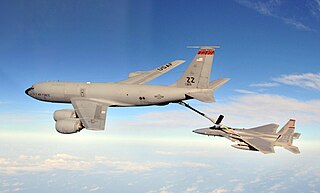
The Boeing KC-135 Stratotanker is an American military aerial refueling aircraft that was developed from the Boeing 367-80 prototype, alongside the Boeing 707 airliner. It is the predominant variant of the C-135 Stratolifter family of transport aircraft. The KC-135 was the US Air Force's first jet-powered refueling tanker and replaced the KC-97 Stratofreighter. The KC-135 was initially tasked with refueling strategic bombers, but it was used extensively in the Vietnam War and later conflicts such as Operation Desert Storm to extend the range and endurance of US tactical fighters and bombers.

The Slovenian Armed Forces or Slovenian Army are the armed forces of Slovenia. Since 2003, it is organized as a fully professional standing army. The Commander-in-Chief of the SAF is the President of the Republic of Slovenia, while operational command is in the domain of the Chief of the General Staff of the Slovenian Armed Forces.
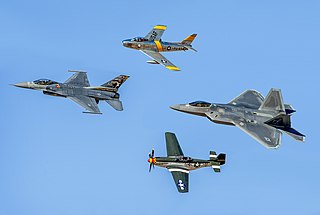
A military aircraft is any fixed-wing or rotary-wing aircraft that is operated by a legal or insurrectionary armed service of any type. Military aircraft can be either combat or non-combat:

Iceland's defence forces consist of the Icelandic Coast Guard, which patrols Icelandic waters and monitors its airspace, and other services such as the National Commissioner's National Security and Special Forces Units. Iceland maintains no standing army, the only NATO member for which this is the case.

The Royal Danish Navy is the sea-based branch of the Danish Defence force. The RDN is mainly responsible for maritime defence and maintaining the sovereignty of Danish territorial waters. Other tasks include surveillance, search and rescue, icebreaking, oil spill recovery and prevention as well as contributions to international tasks and forces.

Aerial refueling, also referred to as air refueling, in-flight refueling (IFR), air-to-air refueling (AAR), and tanking, is the process of transferring aviation fuel from one military aircraft to another during flight. The two main refueling systems are probe-and-drogue, which is simpler to adapt to existing aircraft, and the flying boom, which offers faster fuel transfer, but requires a dedicated boom operator station.
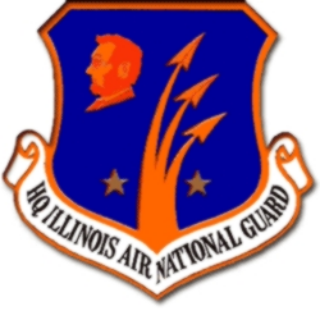
The Illinois Air National Guard is the aerial militia of the State of Illinois, United States of America. It is, along with the Illinois Army National Guard, an element of the Illinois National Guard.

The Royal Norwegian Air Force (RNoAF) is the air force of Norway. It was established as a separate arm of the Norwegian Armed Forces on 10 November 1944. The RNoAF's peacetime establishment is approximately 2,430 employees. 600 personnel also serve their draft period in the RNoAF. After mobilization the RNoAF would consist of approximately 5,500 personnel.
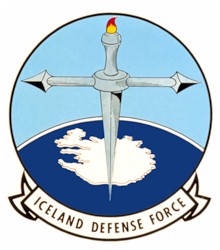
The Iceland Defense Force was a military command of the United States Armed Forces from 1951 to 2006. The IDF, created at the request of NATO, came into existence when the United States signed an agreement to provide for the defense of Iceland, which has only limited defense forces.

The Icelandic Coast Guard is the service responsible for search and rescue, maritime safety and security surveillance, and law enforcement in the seas surrounding Iceland. The Coast Guard maintains the Iceland Air Defence System which conducts ground surveillance of Iceland's air space and operate Keflavik airbase. It is also responsible for hydrographic surveying and nautical charting.
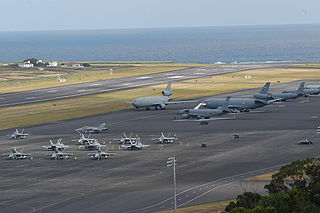
Lajes Field or Lajes Air Base, officially designated Air Base No. 4, is a multi-use airfield near Lajes and 15 km (9.3 mi) northeast of Angra do Heroísmo on Terceira Island in the Azores, Portugal. It is home to the Portuguese Air Force Base Aérea N º4 and Azores Air Zone Command, a United States Air Force detachment unit, and a regional air passenger terminal. Located about 3,680 km (2,290 mi) east of New York City and about 1,600 km (990 mi) west of Lisbon, Portugal; the base sits in a strategic location midway between North America and Europe in the north Atlantic Ocean.

Naval Air Station Keflavik (NASKEF) was a U.S. Navy station at Keflavík International Airport, Iceland, located on the Reykjanes peninsula on the south-west portion of the island. NASKEF was closed on 8 September 2006, and its facilities were taken over by the Icelandic Defence Agency as their primary base until 1 January 2011, when the Agency was abolished and the base handed over to the Icelandic Coast Guard, which has since then operated the base.
Exercise Maple Flag is an annual air combat exercise carried out from CFB Cold Lake over the co-located Cold Lake Air Weapons Range (CLAWR). It is among the largest such exercises in the world, lasting four weeks, split into two two-week "phases". The first Maple Flag was carried out in 1978, initially twice a year, but moved to an annual format in 1987.

The 126th Air Refueling Squadron is a unit of the 128th Air Refueling Wing of the Wisconsin Air National Guard stationed at General Mitchell Air National Guard Base, Wisconsin. The 126th is equipped with the KC-135R Stratotanker.

The 133d Air Refueling Squadron is a unit of the New Hampshire Air National Guard 157th Air Refueling Wing located at Pease Air National Guard Base, Portsmouth, New Hampshire, United States. The 133d, which previously operated the KC-135 Stratotanker, received its first KC-46A Pegasus tanker on 8 August 2019.

The 197th Air Refueling Squadron is a unit of the Arizona Air National Guard 161st Air Refueling Wing located at Goldwater Air National Guard Base, Phoenix, Arizona. The 197th is equipped with the KC-135R Stratotanker.

Exercise Strikeback was a major naval exercise of the North Atlantic Treaty Organization (NATO) that took place over a ten-day period in September 1957.

Icelandic Air Policing is a NATO operation conducted to patrol Iceland's airspace. As Iceland does not have an air force, in 2006 it requested that its NATO allies periodically deploy fighter aircraft to Keflavik Air Base to provide protection of its airspace. The first deployment of aircraft took place in May 2008.

Operation Unified Protector was a NATO operation in 2011 enforcing United Nations Security Council resolutions 1970 and 1973 concerning the Libyan Civil War and adopted on 26 February and 17 March 2011, respectively. These resolutions imposed sanctions on key members of the Gaddafi government and authorized NATO to implement an arms embargo, a no-fly zone and to use all means necessary, short of foreign occupation, to protect Libyan civilians and civilian populated areas.

















